Dallas County COVID-19 Risk Level Lowered
As Dallas County lowers its COVID-19 threat level and local officials warily eye the upcoming Labor Day holiday to determine whether a recent downward trend in new COVID-19 cases continues, there’s a lot of information to keep track of. Here’s what you need to know today:
- Dallas County COVID-19 risk level lowered for first time since May;
- Dallas County reports 358 additional COVID-19 cases, six more deaths;
- DCHHS opening COVID-19 quarantine housing program.
Dallas County COVID-19 Risk Level Lowered For First Time Since May
Dallas County health officials now say it’s safe to get a haircut (as long as the salon takes precautions), dine-in at restaurants (provided there’s plenty of space between tables and masks are worn), or visit museums or libraries with 25% or less occupancy.
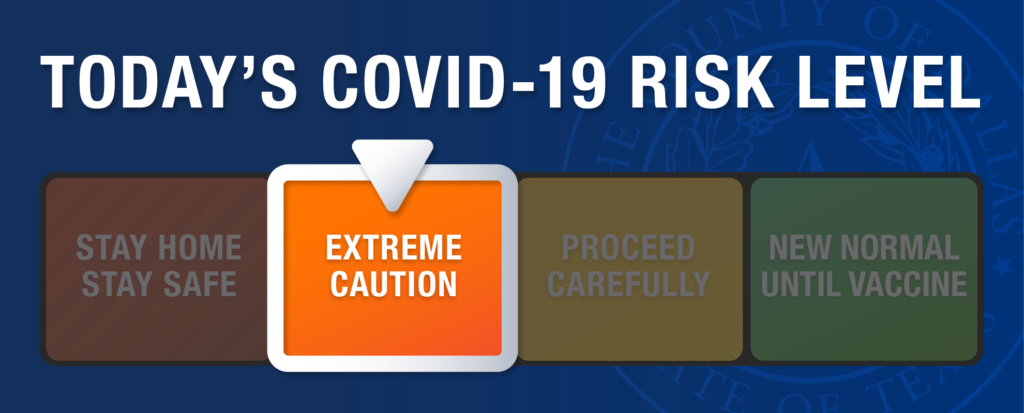
Dallas County officials announced Wednesday that they were lowering the color-coded COVID-19 risk level chart from red to orange for the first time since the chart and health guidance for the public were debuted in May. The nonbinding guidance was compiled by experts in public health and epidemiology as the economy began to reopen in hopes of informing residents about the activities they deemed safe, whether or not they were allowed at the state level.
Last week, we reported a change in the county’s COVID-19 threat level may have been in the works.
“This achievement is due to what you as a community have done – wearing your mask, six foot distance, washing your hands, avoiding unnecessary trips and, up until now, avoiding those indoor activities where a mask could not be worn 100% of the time,” Dallas County Judge Clay Jenkins said.
He also warned residents to continue to follow public health guidance going into the Labor Day holiday.
“We’ve had two events here in Dallas County that have shot up COVID – Easter/Passover and Memorial Day. Ten days after each of those events, we saw a huge increase in COVID,” Jenkins said. “You did a great job on July 4 in wearing your mask and not going out to big stranger celebrations and big group celebrations. We didn’t see a spike on July 4… Labor Day has to be like July 4 was, not like Memorial Day.”
Dallas County Health and Human Services Director Dr. Philip Huang echoed Jenkins’ warning and called the situation “precarious.”
“The cautionary tone in all of this is that it’s flattening out… and, as the judge mentioned, it’s really very important that, as we move from red to orange, it doesn’t mean we can open up and just do everything – go back to normal. We have to keep doing all the things that got us here that made us to be successful,” Huang said.
He said county officials looked at metrics like hospitalizations, deaths, and cumulative positivity rates in making their decision.
“We did not meet all of the indicators that we’ve been looking at, but what we’ve been looking at is if we were meeting the indicators for 75% in each of the various categories, that that was enough for us to move from red to orange,” Huang said.
Specifically, he said the county didn’t meet the percent positivity indicator of 10%.
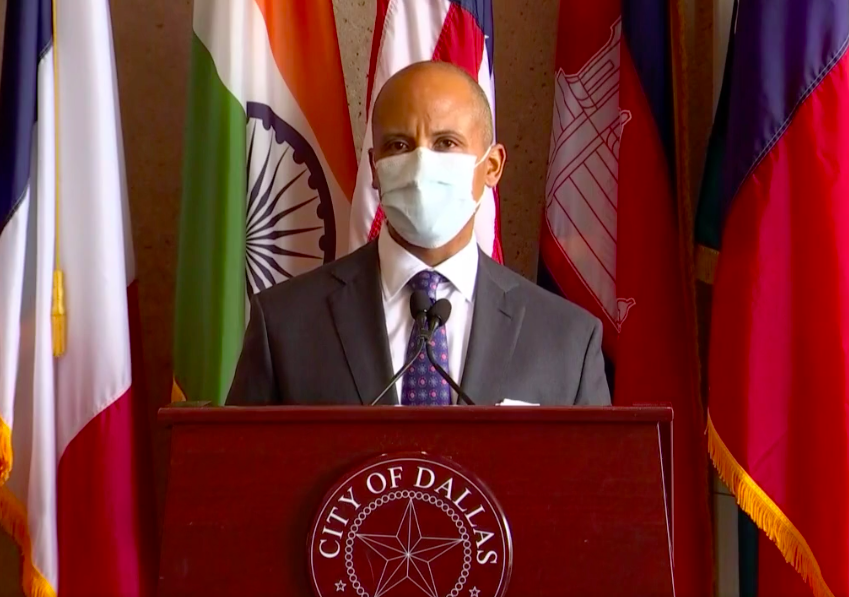
Dallas’ COVID-19 health and healthcare access czar Dr. Kelvin Baggett also emphasized the importance of continuing to take precautions during the holiday weekend.
“We are pleased to see the numbers, based upon what we know to be declining. We are pleased to see that we are progressing from a state of red, where we’ve been since May, to a state of orange, but we still remain deeply concerned. We are deeply concerned that there may be some misinterpretation that this means that everything’s OK and that we can return back to the old normal,” Baggett said. “Yes, we have made progress, but we must commit to remaining vigilant, to staying on guard, to doing everything that we know and everything that we possibly can to continue to support this decline and to suppress this spread.”
Dallas County Reports 358 Additional COVID-19 Cases, Six More Deaths
Dallas County Health and Human Services Wednesday reported 358 additional confirmed cases of COVID-19, bringing the total confirmed case count in Dallas County to 72,610, as well as six more confirmed deaths with one probable death. Of the 358 new cases reported Wednesday, 207 came through the Texas Department of State Health Services’ (DSHS) electronic laboratory reporting (ELR) system and 35 were from months prior to August–one from May, 12 from June, and 22 from July.
The total number of probable cases in Dallas County is 3,025, including 10 probable deaths from COVID-19.
Among the additional deaths reported Wednesday were a Dallas man in his 50s who didn’t have underlying conditions, a Dallas man in his 60s, a Dallas woman in her 60s, a Lancaster woman in her 70s who didn’t have underlying health conditions, a Richardson man in his 80s, and a DeSoto woman in her 90s.
Of the 926 total confirmed deaths reported to date, about 25% have been associated with long-term care facilities. Among the additional deaths reported Wednesday was a woman in her 70s who lived in a Dallas facility.
From Aug. 8-21, 393 school-aged children between 5 and 18 years of age were diagnosed with COVID-19 in Dallas County. About 50% of these cases were high school age. By zip code of residence, 203 (51%) of these children were projected to have been enrolled in Dallas ISD schools, and 2% in Highland Park ISD.
Of all confirmed cases requiring hospitalization to date, more than two-thirds have been under 65 years of age.
“According to the Public Health Committee, we have met the criteria to now move from the ‘Red’ high-risk level into the ‘Orange’ moderate-risk level. We had been in the ‘Red’ risk-level since we announced the color-coded risk chart in May, and as we saw record numbers of cases and hospitalizations over the summer,” said Jenkins.
“I know the move to the ‘Orange’ level is because of the hard work of Dallas County residents who have worn their masks, maintained social distances and made sacrifices for the greater good. The Public Health Guidance document that shows what medical experts say you can safely do in the ‘Orange’ level is on our website at www.DallasCountyCOVID.org. With all activities, we should continue to wear our mask, maintain social distancing, and use good hand hygiene. I do want to remind high-risk individuals and those over the age of 65 to continue to exercise extreme caution in all of their outside activities as the loosened restrictions in “Orange” do not apply to the high-risk group.
Our Public Health Committee is still asking residents to avoid large gatherings of more than 10 people including family events, gyms, movie theaters and other indoor entertainment settings, and team sports. This is especially important to remember as we head into Labor Day weekend and our last big holiday weekend of the summer. We saw a very significant increase in cases and hospitalizations following the Memorial Day holiday. It’s taken us three months to recover from that spike. Our numbers can rise very quickly when we let our guard down. If that happens over Labor Day, we will be in the midst of the holiday season where we would like to safely celebrate with our loved ones. We must continue to exercise caution as this is a marathon. I’m confident we can do this and find ways to keep businesses open, get all of our kids back in school, and most importantly, keep more people from getting sick.”
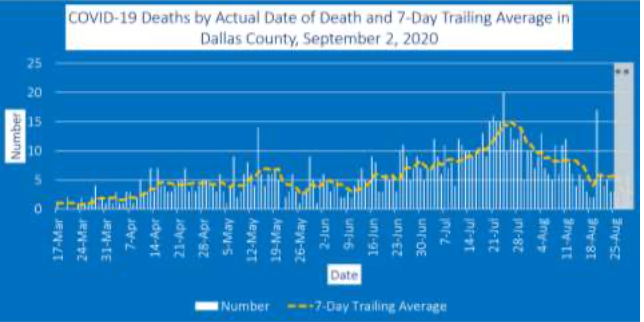
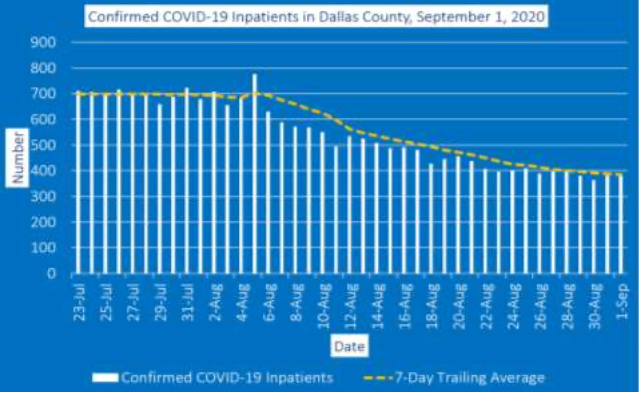
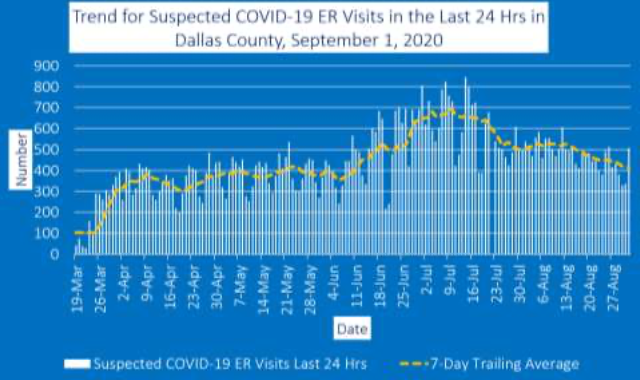
The county reported 378 COVID-19 patients in hospitals Tuesday, and the number of emergency room visits for COVID-19 like symptoms in Dallas County was 505, which represents around 17% of all emergency department visits in the county according to information reported to the North Central Texas Trauma Regional Advisory Council.
The percentage of respiratory specimens testing positive for the virus that causes COVID-19 continues to decline but remains high, with 11.3% of symptomatic patients presenting to area hospitals testing positive in week 34.
DCHHS Opening COVID-19 Quarantine Housing Program
Dallas County Health and Human Services Wednesday announced the opening of the a COVID-19 quarantine housing program for Dallas County residents with mild cases.
The program is meant to provide temporary housing for non-complex persons diagnosed with COVID-19 (meaning those who don’t require medical equipment like a ventilator or in-person, round-the-clock medical care, and who aren’t drug users or homeless) who need to quarantine for 14-21 days, but are unable to return home because of situations like an immunocompromised relative, elderly parents at home, etc.
“Some people are in situations where quarantining at home is not feasible. This program allows those individuals to isolate without exposing other household members,” Huang said. “As we continue to fight COVID-19, this program will help slow the spread of the virus in Dallas County.”
Referral applications to the program may be submitted by healthcare providers who are physicians, NP, PA, RN, and/or social workers from area hospitals, ERs, and/or private physicians’ offices.
Submission of a referral application doesn’t guarantee eligibility or offer of assistance. The program is available only to individuals who reside in Dallas County outside the city of Dallas.
DCHHS is accepting applications online based on availability. The sheltering site will remain in operation through Dec. 30.
For questions, call 214-819-5143.









